A gentle, homemade version of red shiso furikake, with the freedom to adjust the saltiness to your taste.
Perfect on rice, onigiri, and mixed rice, and just as delicious sprinkled over pasta, fresh cucumber, potatoes, or cabbage. A colorful, versatile vegan Japanese seasoning to keep in your pantry.
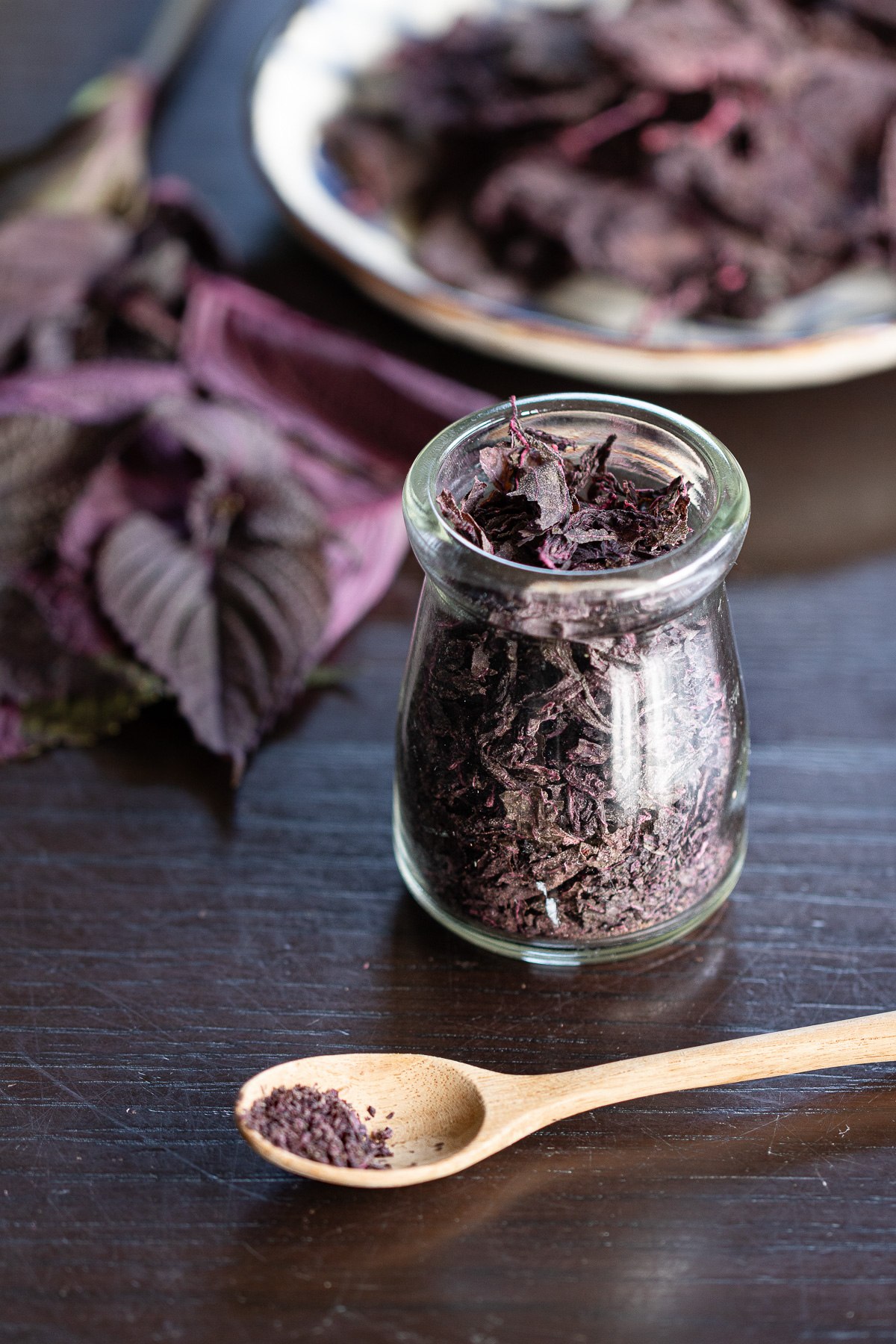
Bright red and beautifully fragrant, this homemade vegan furikake captures the taste of summer in a jar.
Jump to:
- 🌿 Journal from the Kitchen
- 🧺 Features of This Recipe
- 🥢 Ingredients
- 🥣 How to Make Red Shiso Furikake (Yukari-style)
- 🪄 Ways to Enjoy & Variations
- 🍃 Storage
- 📚 FAQ
- 📘 Kitchen Notes|Tips & Using Green Shiso
- 🎨 Summer Recipes to Play with Color
- 🫙 Bottling Seasonal Memories...
- 📖 Recipe Card|Printable Recipes
- 💐 Closing Thoughts
🌿 Journal from the Kitchen
In my home, the red shiso is ready for harvest a little later than the ume season.
So my umeboshi are kept simple — just salt and plums, no shiso added.
The furikake, of course, is made separately.
That way I can season it lightly, and it becomes its own little handcraft to enjoy.
Making furikake after umeboshi feels like a quiet meditation.
Picking the shiso leaves, rinsing them clean, drying them carefully.
Salting and kneading to draw out the astringency, then gently kneading again.
Between the steps, I take pauses, unhurried.
With a glass of freshly made ume chai syrup in hand, I sit by the fan, letting the summer wind carry both the scent of shiso and a sense of quiet fulfillment through the room.
When the leaves turn a deep red-purple, I spread them out on plates and let them dry under the sun.
Before the afternoon humidity sets in, I gather them up and begin to crumble them: crackle, crunch, rustle.
The sound itself feels light and soothing.
It’s about the same time I’d bring in the futons from the balcony.
I pause, take a deep breath, and give thanks for the summer light.
Yes — summer is still here.
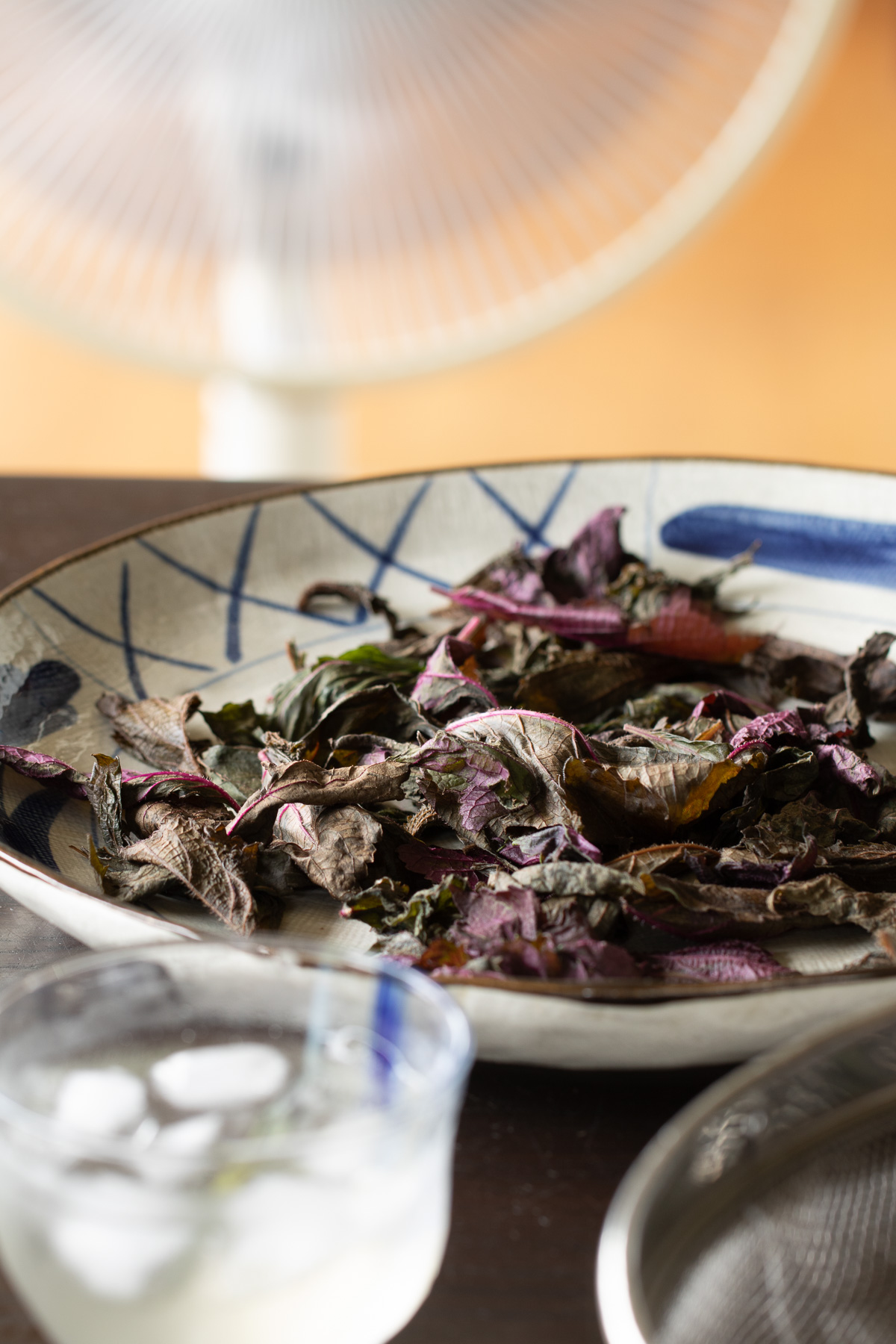
🧺 Features of This Recipe
- A vegan, homemade seasoning with no additives — just shiso, salt and plum vinegar
- Bright and naturally vibrant in color, adding joy to simple meals
- Salt level can be adjusted to taste — lighter than many store-bought versions if you prefer
- Versatile: perfect for rice, onigiri, mixed rice, pasta, cucumbers, potatoes, or cabbage
- A recipe that carries the spirit of Japanese summer handcrafts into everyday cooking
🥢 Ingredients
- 75 g fresh red shiso leaves (perilla leaves), measured after drying
- 7–8 g sea salt (about 10% of the dried shiso weight)
- 2–3 tablespoon umezu (pickling brine from umeboshi, also called plum vinegar)
Optional
- Fresh green shiso (can be used instead of or together with red shiso; gives a lighter color but a refreshing aroma)
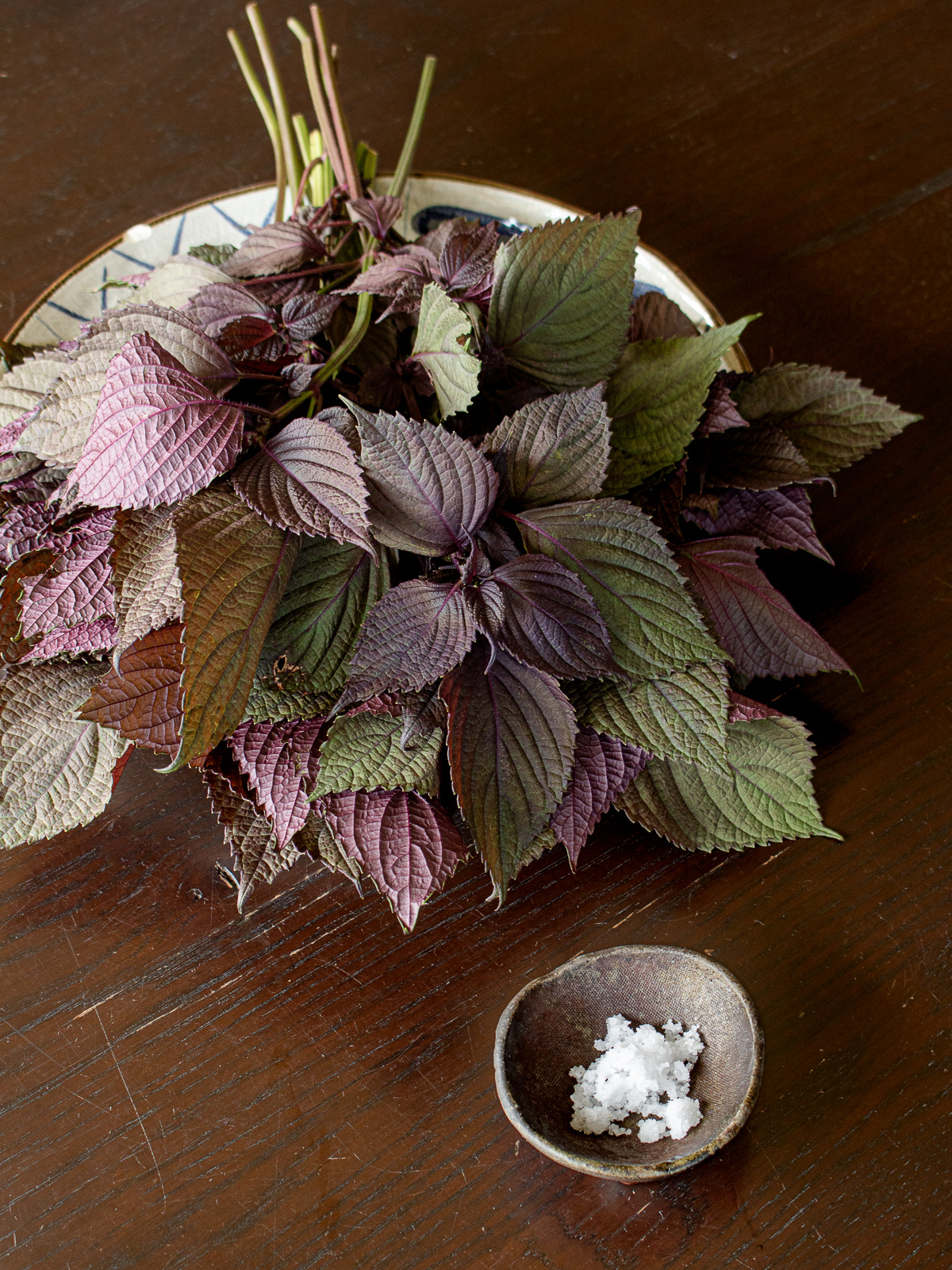
👇 For detailed amounts, scroll to the printable recipe card below.
🥣 How to Make Red Shiso Furikake (Yukari-style)
A gentle, fragrant summer ritual—washing, salting, and drying red shiso leaves over two days to create your own vibrant yukari furikake.
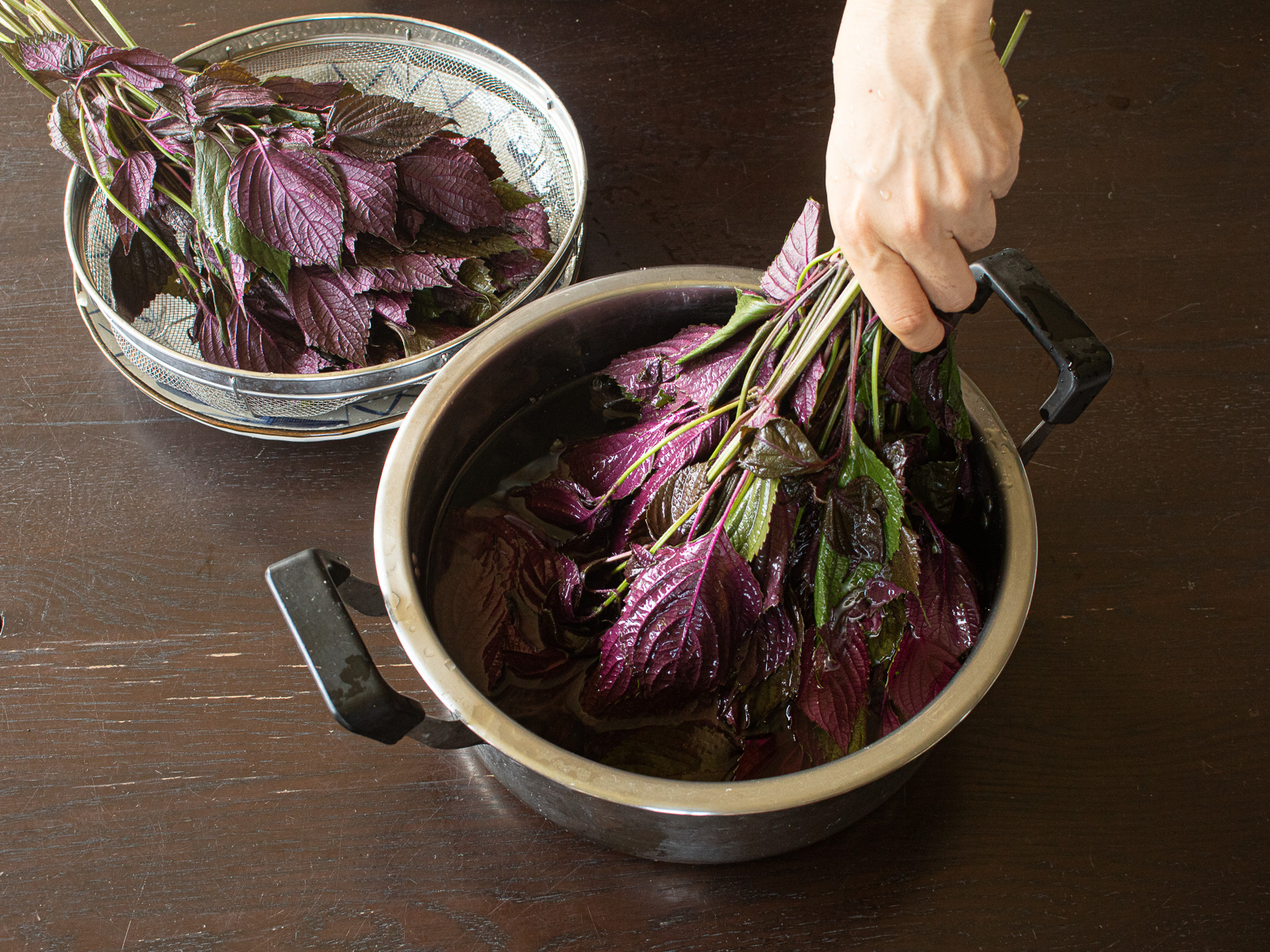
- Wash the red shiso
Place the red shiso, stems and all, in a large bowl of water and gently shake them to remove any dirt. Drain thoroughly.
🌿 The motion of shaking the stems helps shed water quickly—and feels delightfully refreshing.
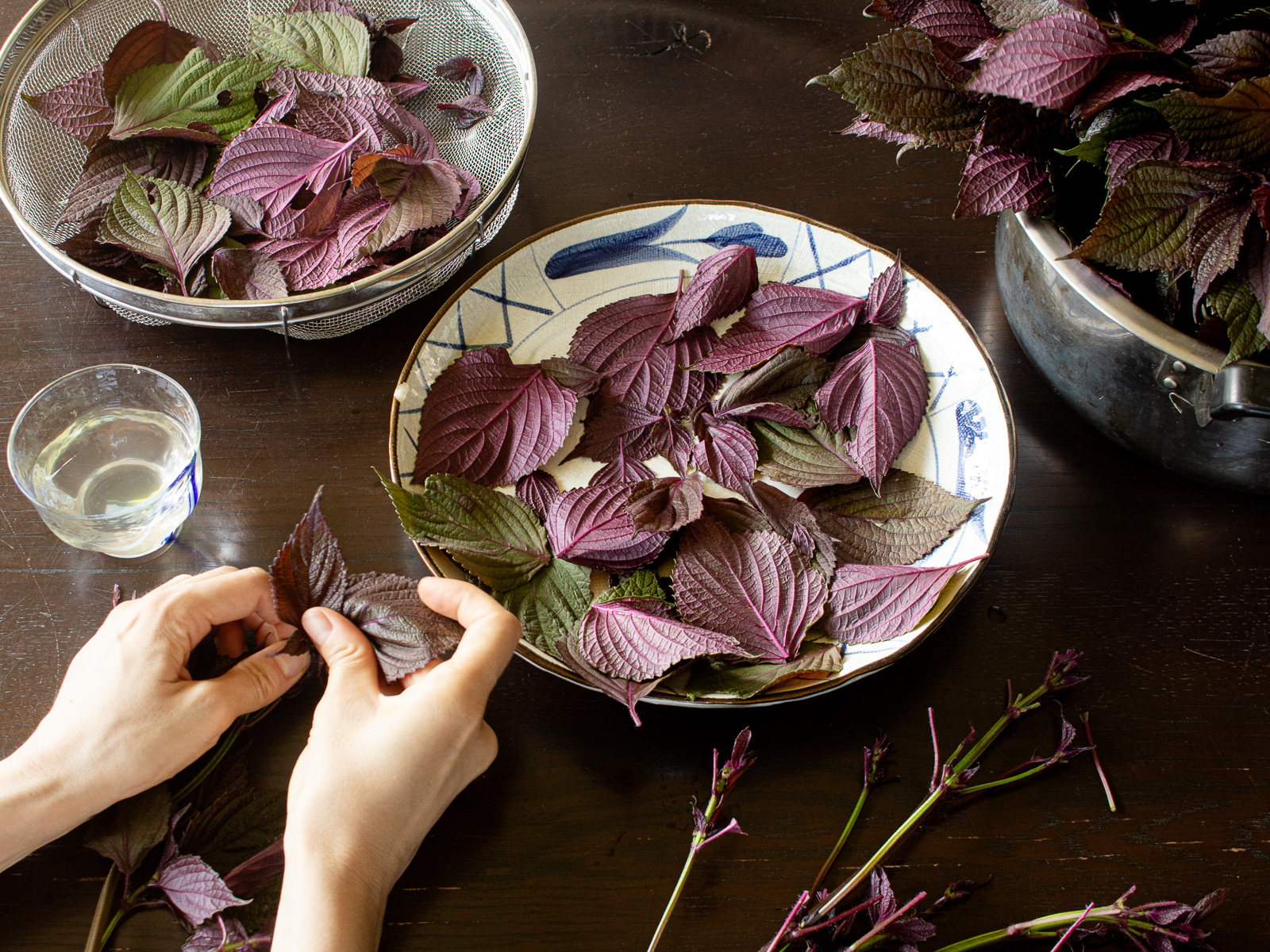
- Separate and dry the leaves
Pull the leaves from the stems and lay them on plates or a colander. Let them air-dry in a breezy spot.
🌿 Leaves should not be completely crisp—leave a little moisture so they are easy to handle.
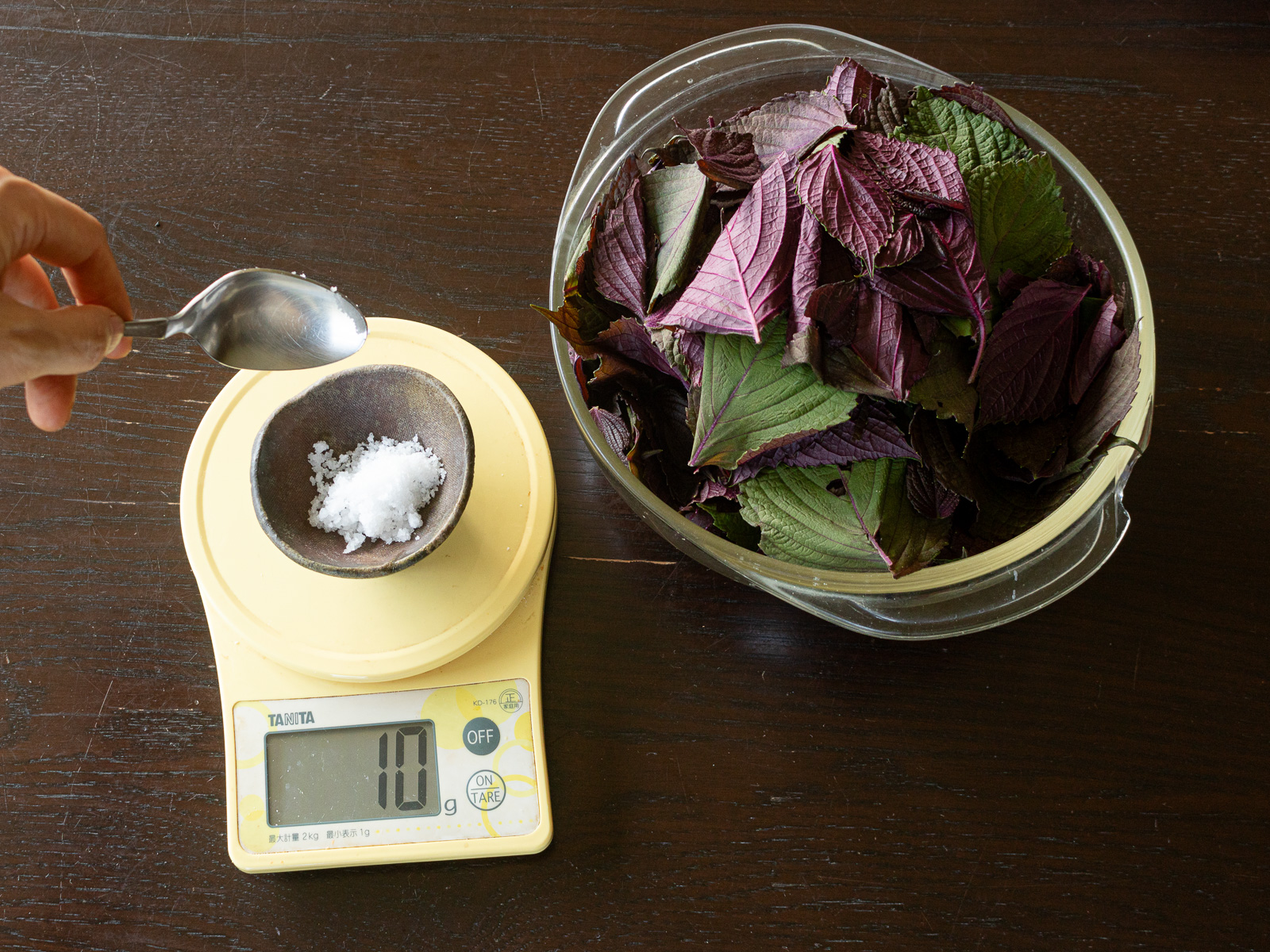
- Measure leaves and salt
Weigh the dried leaves and prepare 10% of that weight in salt.
🌿 Always measure after drying, not before.
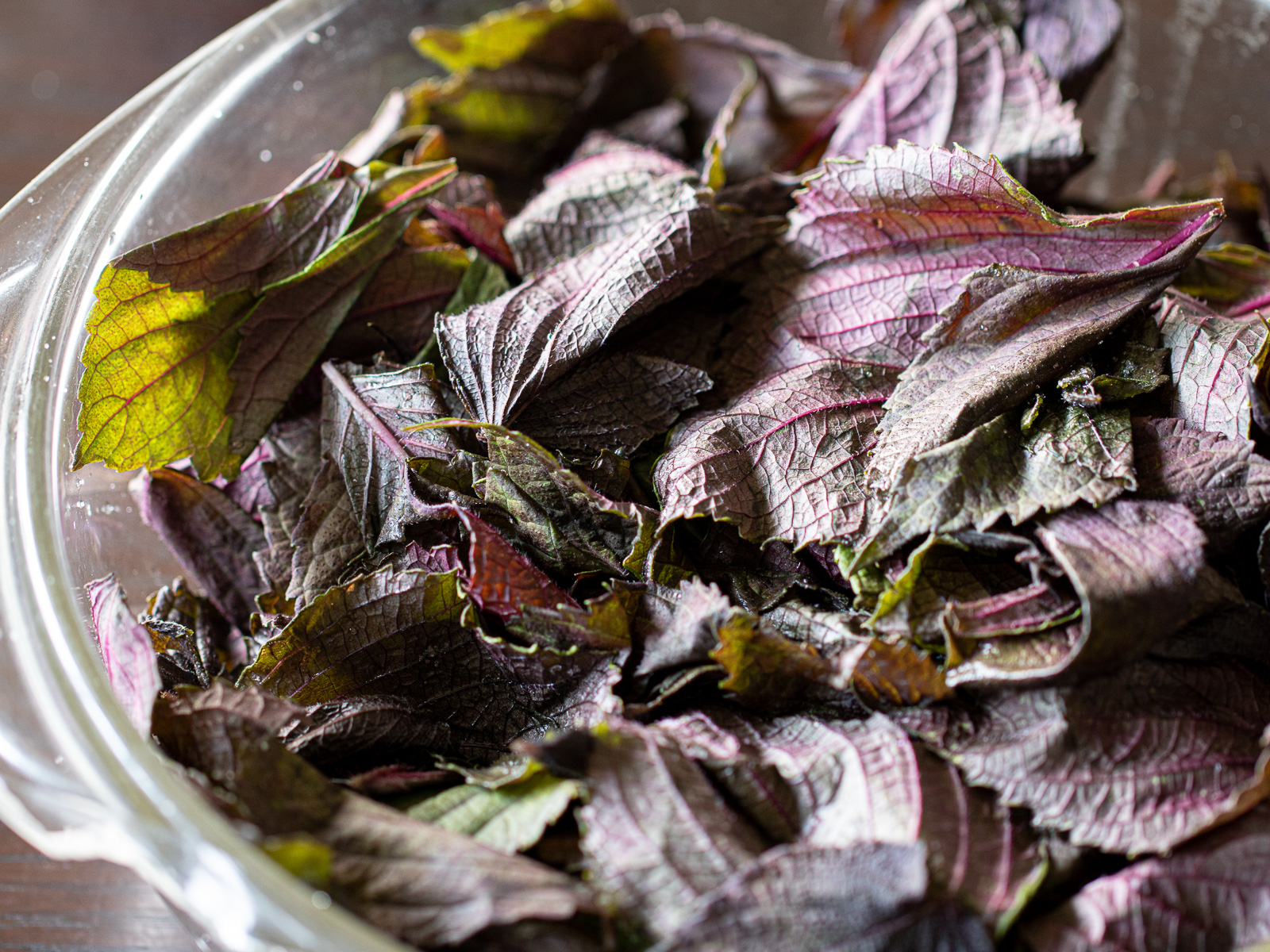
- First salting
Sprinkle half the salt over the leaves in a bowl, mixing lightly.
Let them sit for 30 minutes until the leaves soften.
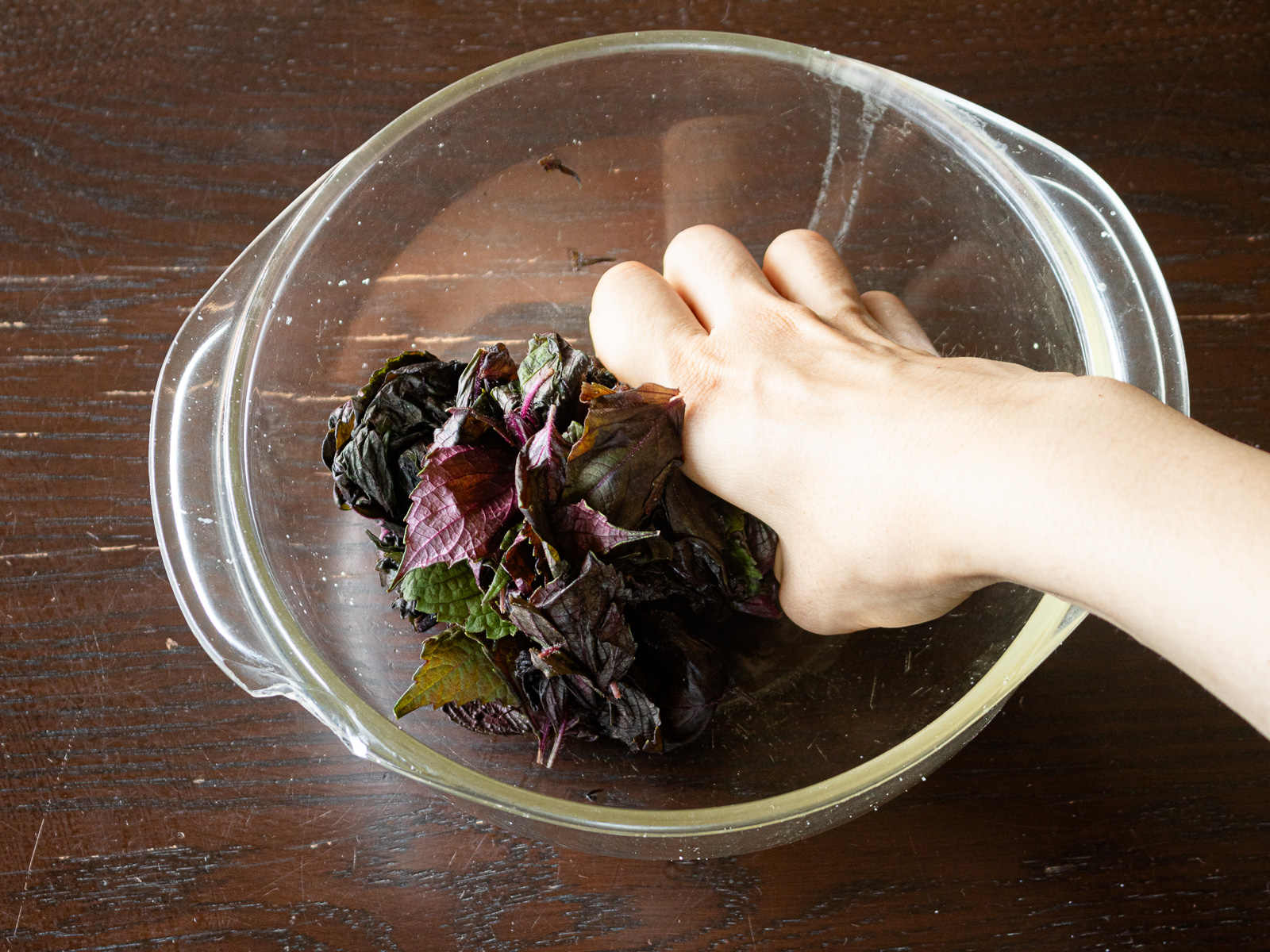
- Massage leaves
Gently press and massage the leaves until dark juice appears.
🌿 Pressing helps release color and aroma naturally.
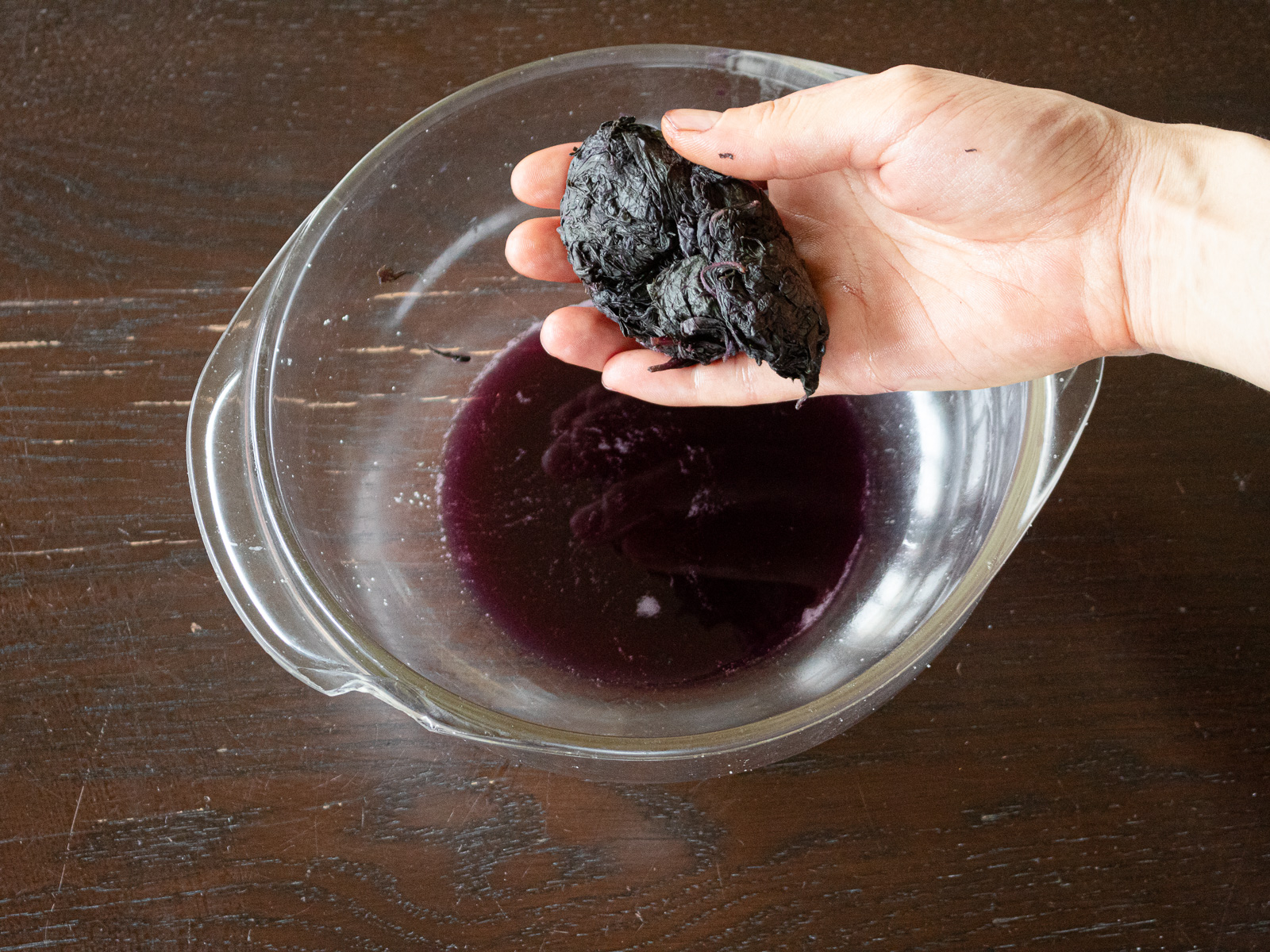
- Drain
Squeeze the leaves firmly to remove the juice and discard the liquid.
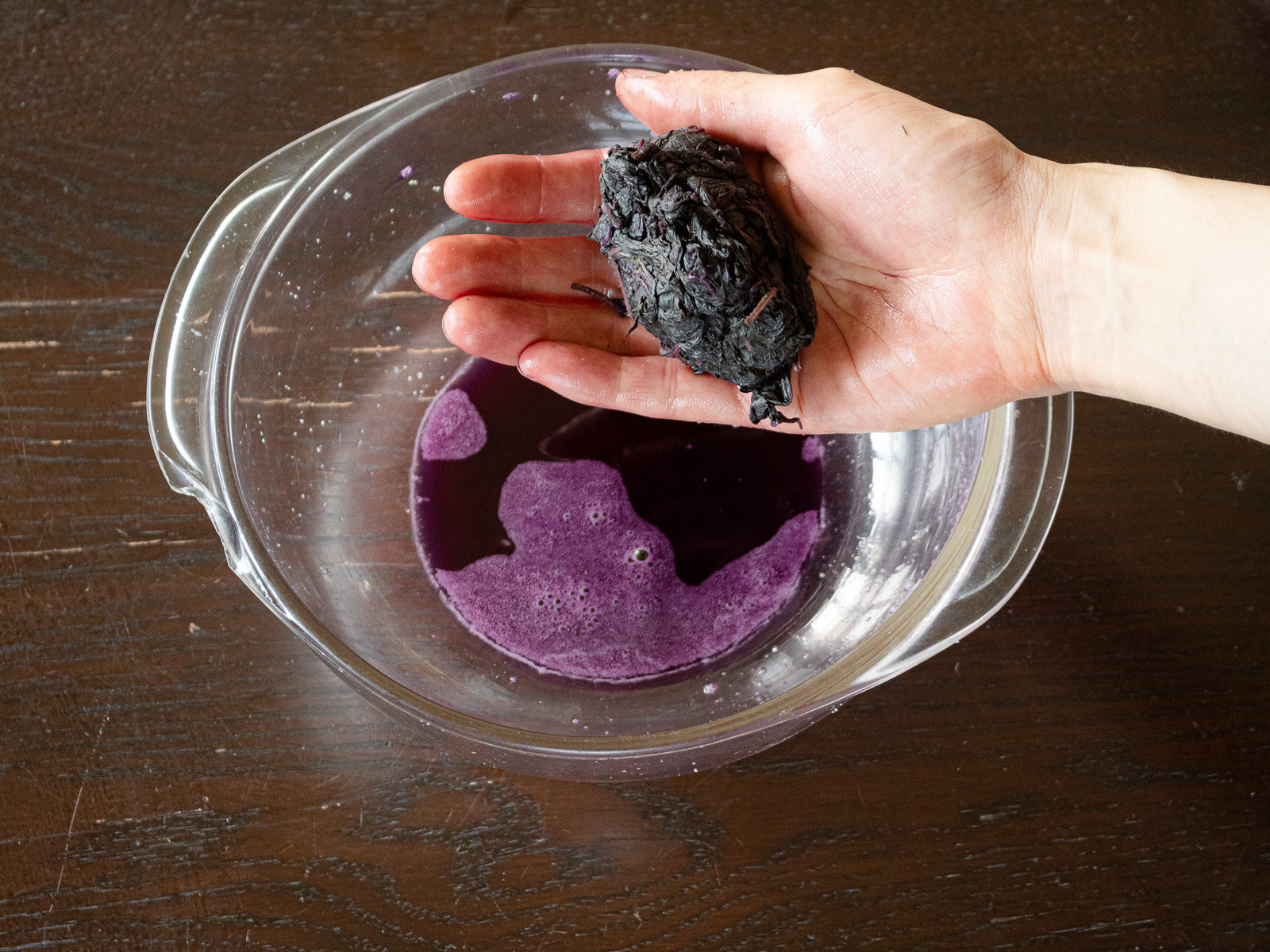
- Second salting
Sprinkle the remaining salt, massage again until more reddish-purple liquid is released, and squeeze once more and discard the liquid.
🌿 The first round brings out color, the second enhances fragrance.
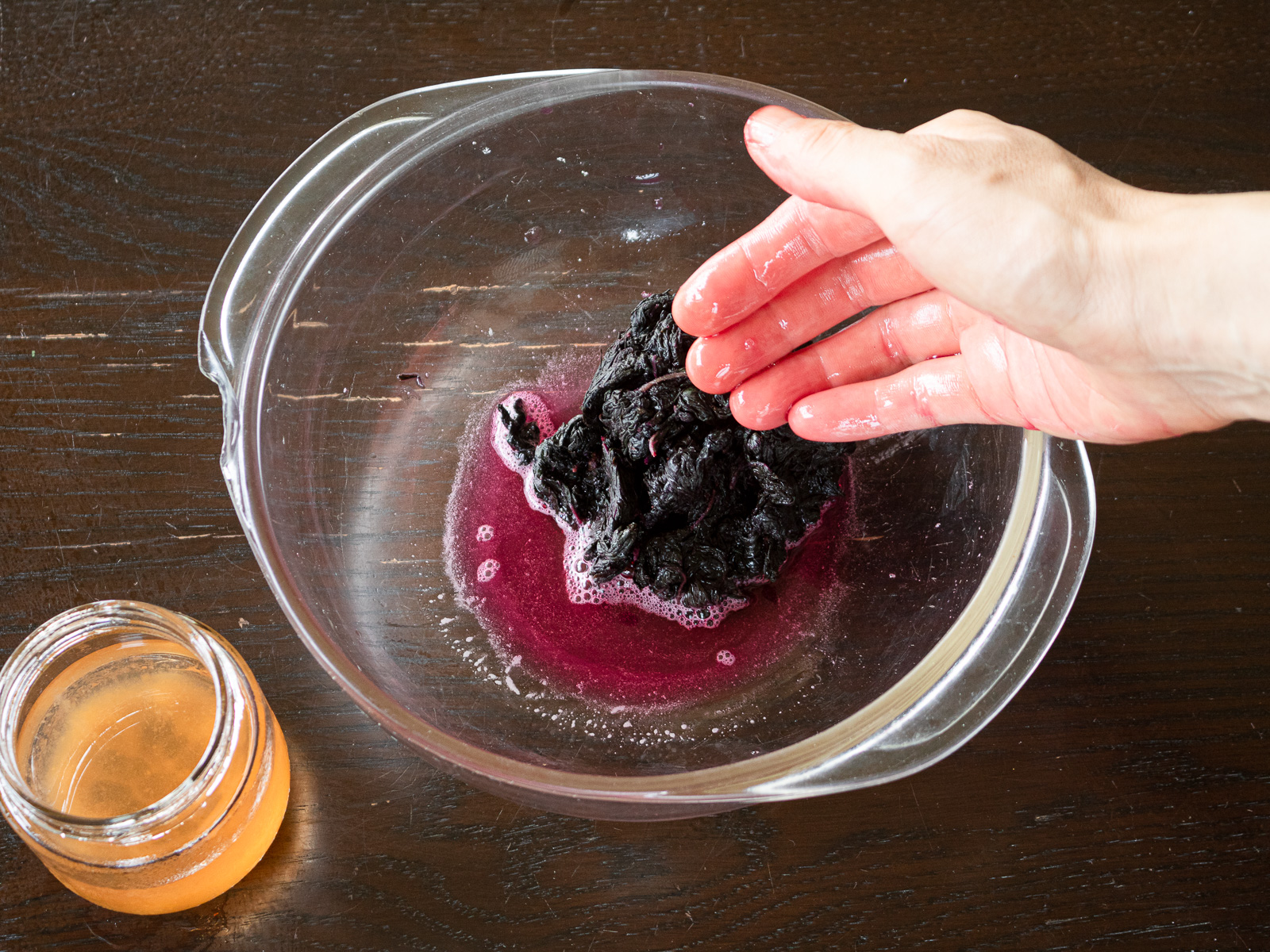
- Add ume vinegar
Add ume vinegar (1 tablespoon per 25 g of leaves) and gently massage so it is evenly absorbed. The leaves should turn a vibrant pink.
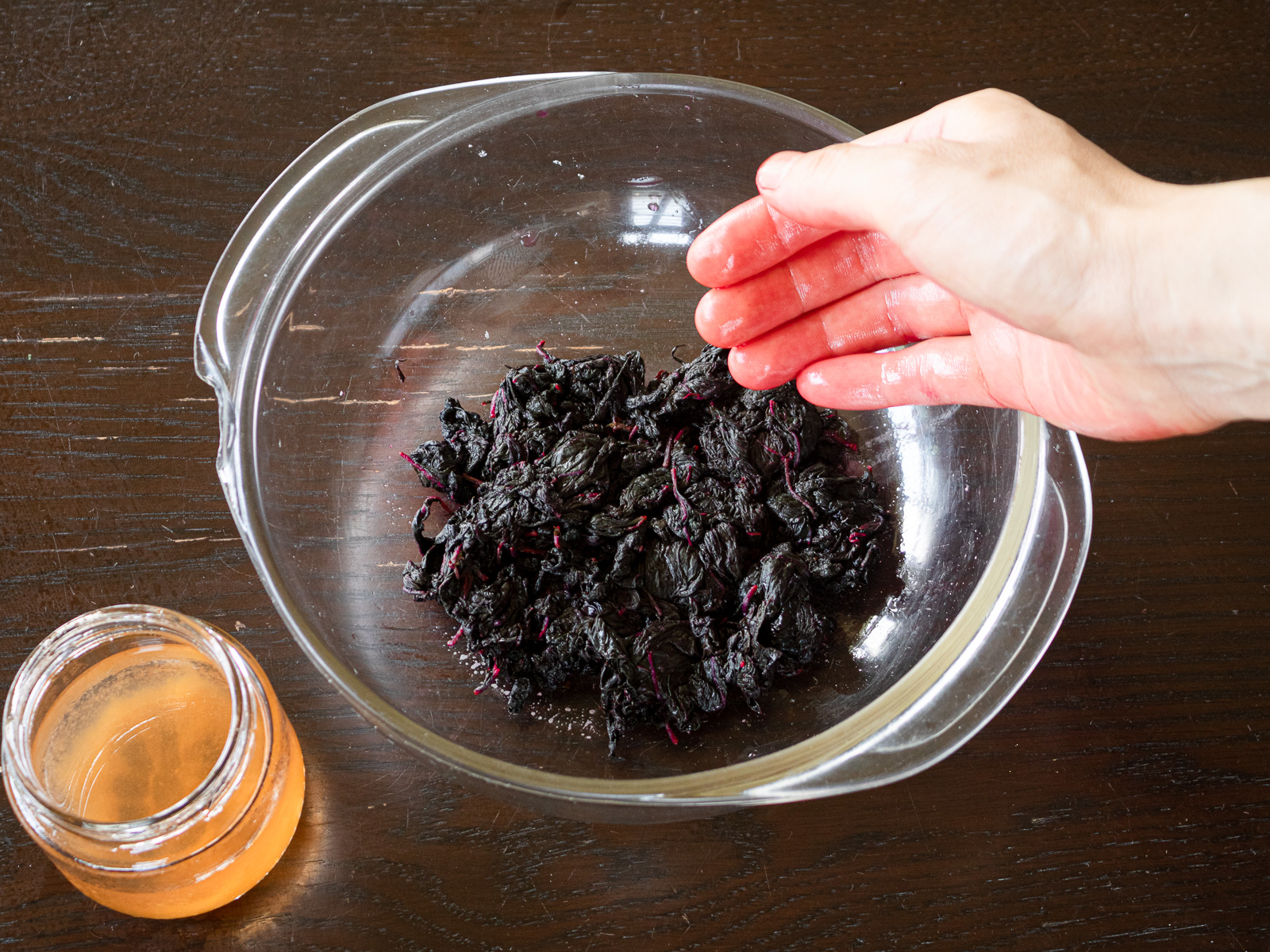
- Let sit overnight
Place in a container to prevent drying and let it sit in the refrigerator overnight for the color to set.
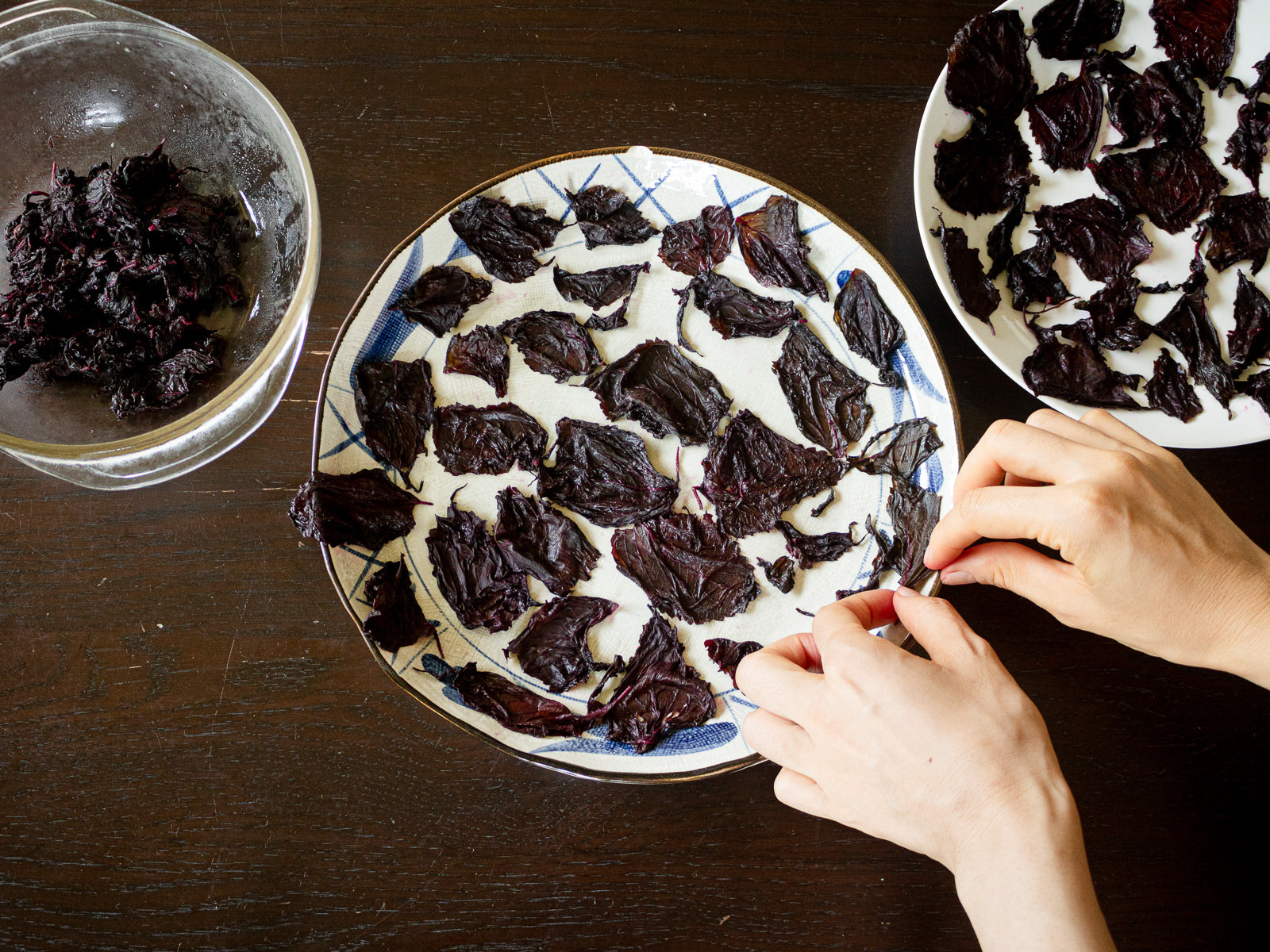
- Arrange for drying
The next day, spread the leaves on a tray or plate so they do not overlap.
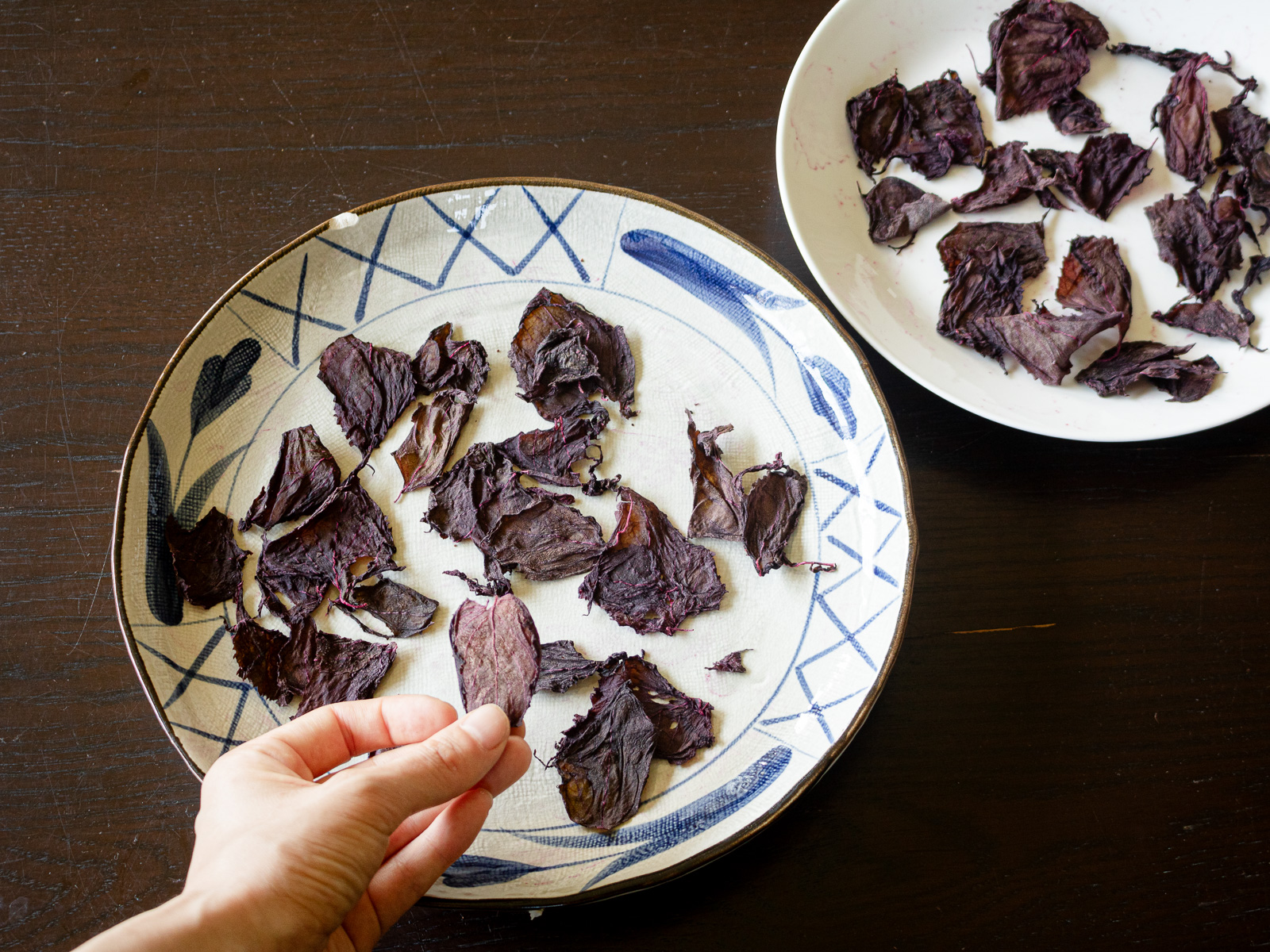
- Dry completely
Dry them in the shade or under gentle sunlight until crisp.
🌿 Partially dried leaves reduce shelf life, so make sure they are thoroughly dried.
🌿 Sun-drying gives a traditional texture, while shade-drying preserves a gentler color and aroma.
roma.
🌿 If the weather is bad, dry indoors or in a low-temperature oven (around 80°C) for a few minutes, then let them finish drying with residual heat. Watch carefully to avoid burning.
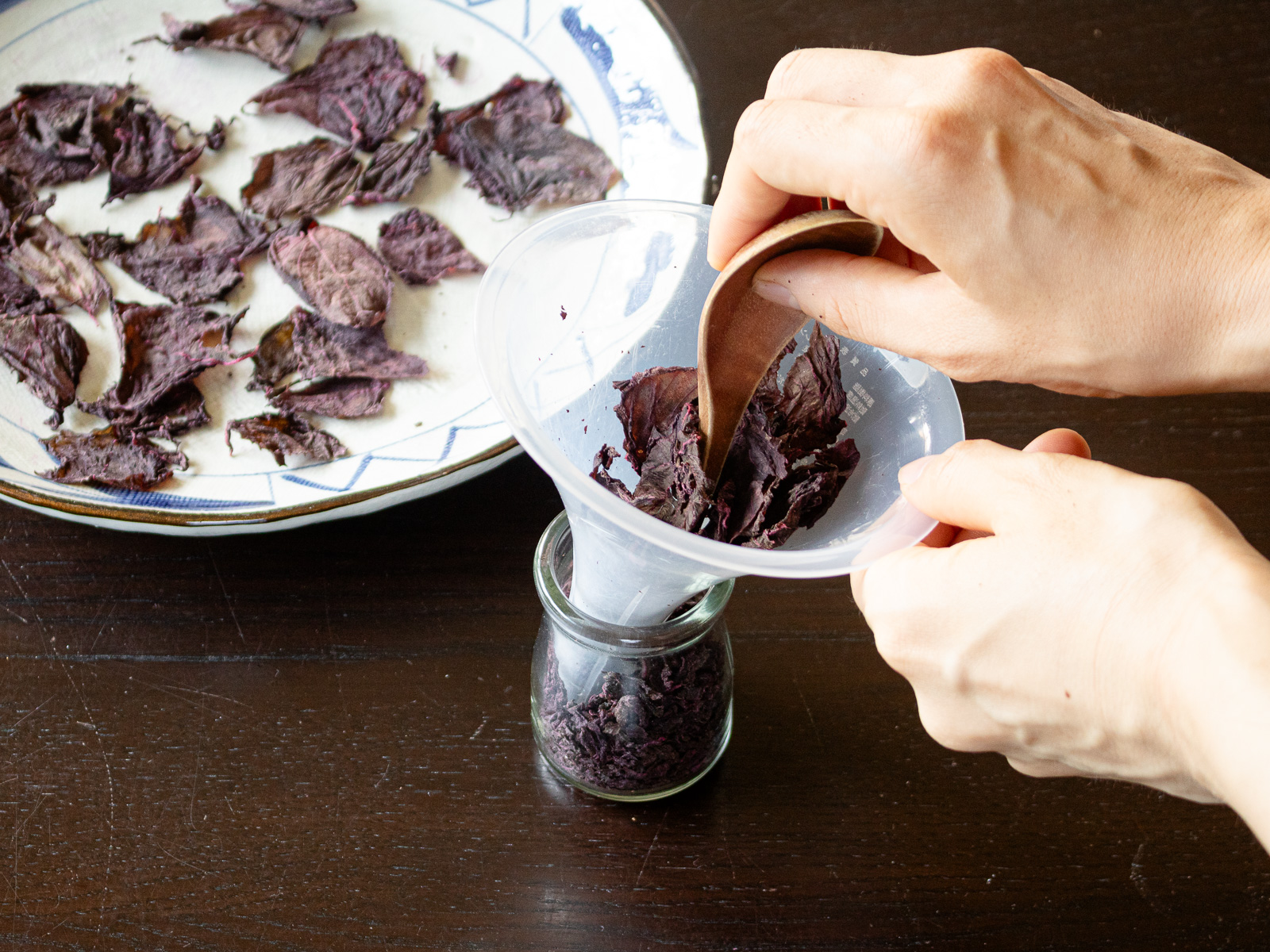
- Finish and store
Once fully dry, transfer the shiso into a jar using a funnel. Crush slightly with a spoon handle or chopstick for a finer texture.
Your fragrant homemade red shiso yukari furikake is ready.
Sprinkle over rice, tofu, or seasonal dishes for a touch of summer’s color and aroma.
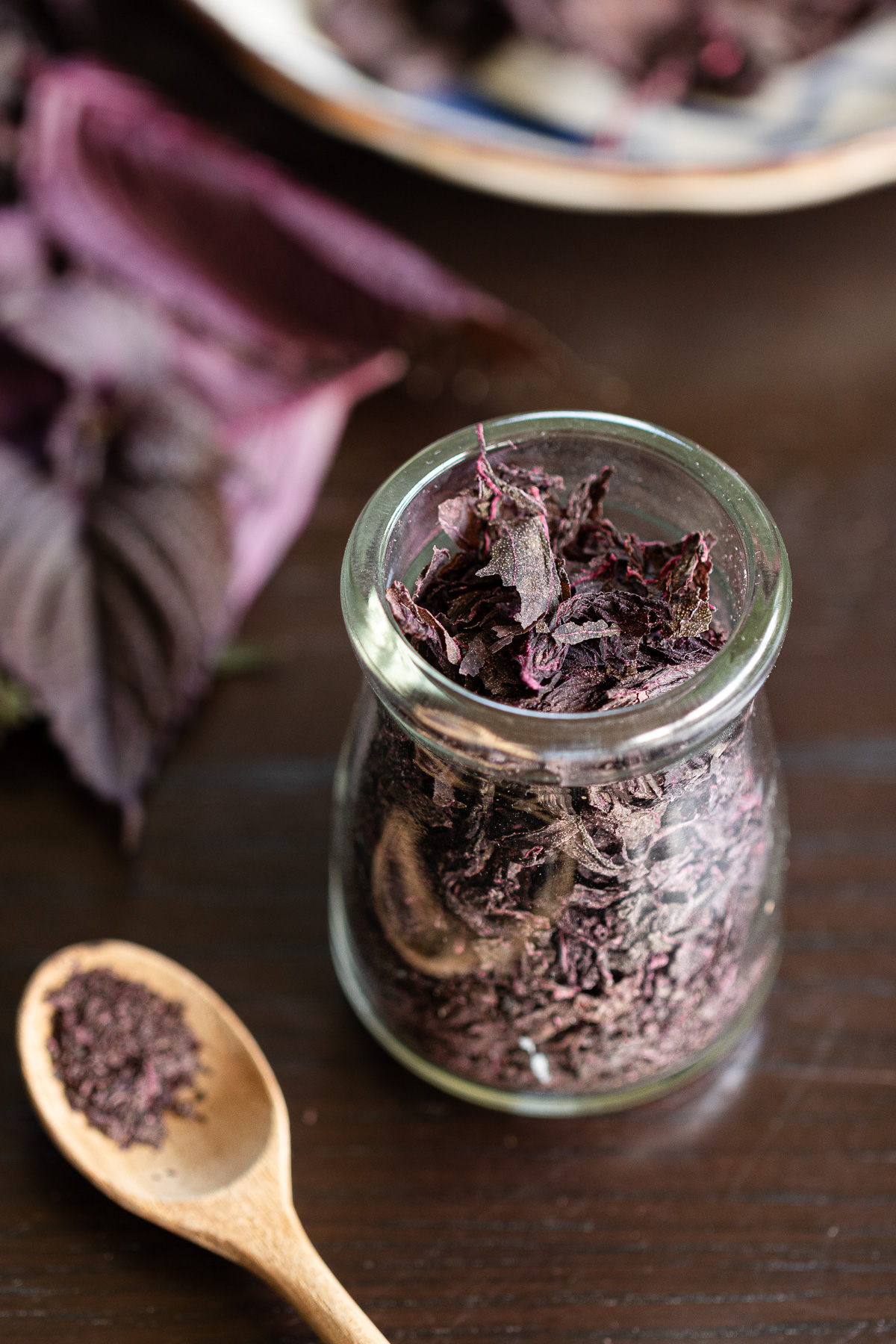
🪄 Ways to Enjoy & Variations
- Onigiri – use instead of plain salt for simple rice balls.
- Mixed Rice – just stir into freshly cooked rice.
- Pasta – toss with olive oil for a Japanese-style aglio e olio.
- Cucumber Salad – mix with thinly sliced cucumber for a quick pickled taste.
- Nagaimo or Potatoes – sprinkle over raw nagaimo sticks or steamed potatoes.
- Cabbage – lightly boil and season with shiso for a refreshing side.
- Tofu – a bright, fragrant topping for chilled tofu.
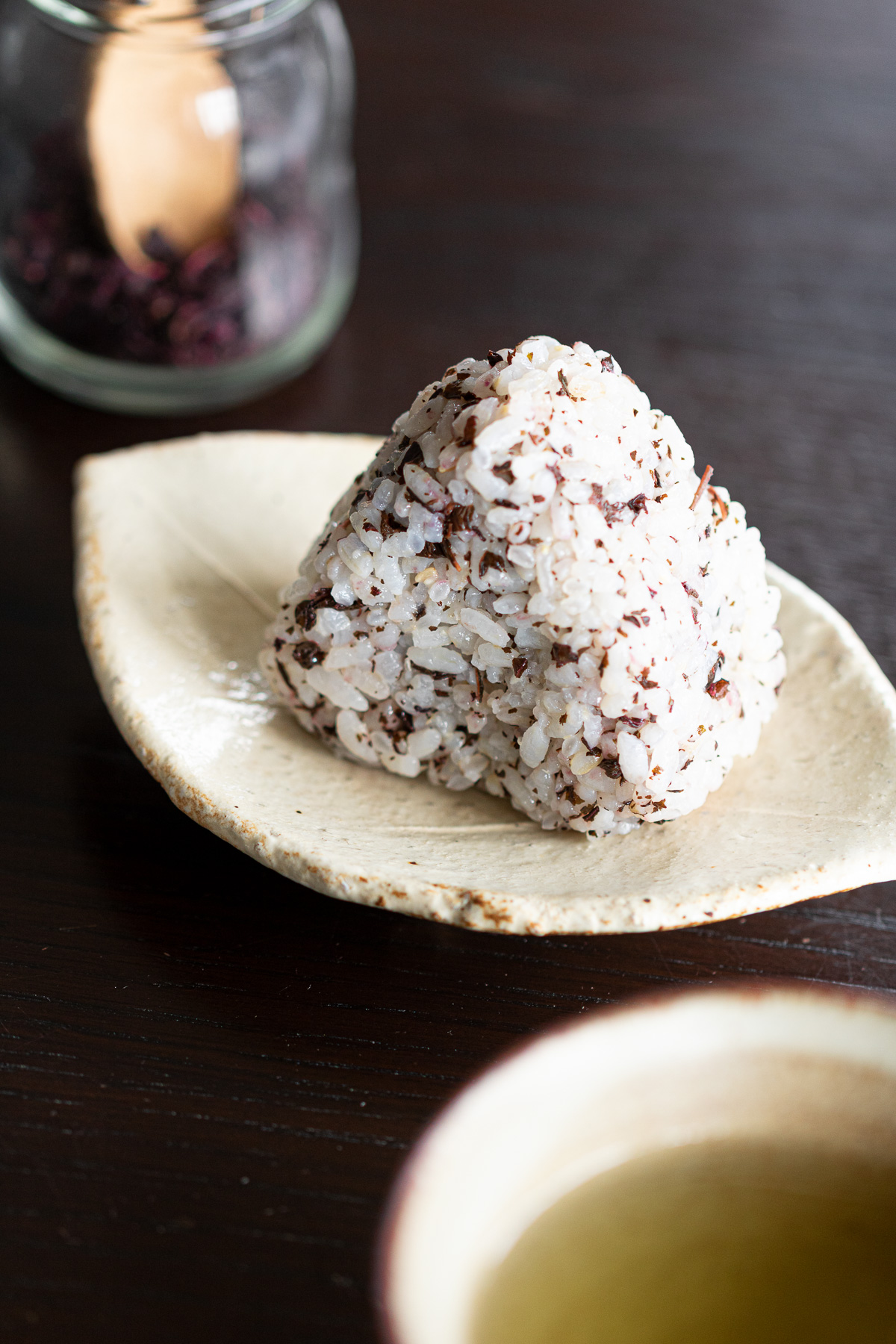
🍃 Storage
- Store in a clean, dry jar or airtight container at room temperature.
- Will keep its bright color and aroma for 1–2 months if away from humidity.
- For a longer-lasting freshness, tuck it into the refrigerator.
📚 FAQ
Don’t worry if you only have a small bunch. It works from about 25g, though the color may come out more gently. For the most vibrant results, 75g or more is easier to handle.
Always after washing and drying. Freshly washed leaves hold a lot of water, which can make the weight misleading and the furikake too salty.
The first round is when the liquid turns dark, the second when the fragrance deepens. Spread the leaves out and check—if you see green patches, keep going a little longer.
Lay the leaves out so they don’t overlap and let the sun or a breezy shade do the work until crisp.
Yes. The color won’t be as vivid, but the refreshing fragrance is lovely.
Once fully dried, keep it in a sealed jar at room temperature for a few months. A cool, dry spot helps preserve the fragrance.
📘 Kitchen Notes|Tips & Using Green Shiso
▶ Amount of red shiso
Working with too small a batch makes it hard to massage the leaves and bring out the deep color. A minimum of 75–100g dried leaves is easiest to handle.
Of course, even a small amount can be delicious. If the color turns out lighter, that too becomes part of the memory of this summer.
▶ Salt
Type of salt:
Both natural coarse salt and refined salt work well. Coarse salt gives a rounder flavor, while refined salt makes for a sharper, more direct taste.
Amount of salt:
Always weigh the shiso after drying, then use 10% of that weight in salt.
If you prefer a stronger taste, you can increase the salt slightly, or adjust after the furikake is finished.
If you want it less salty:
You can gently squeeze out some of the ume vinegar before drying, which lightens the saltiness while keeping the fragrance.
Or simply use a little less ume vinegar — about one tablespoon is enough for a softer taste.
▶ Preparing the leaves
Drying before salting:
This step takes a little care.
If the leaves are too dry, they crumble and lose their color when massaged. Too wet, and the color won’t come out either. Aim for the middle ground—soft and pliable, just slightly moist.
Massaging:
Massage long enough to release fragrance and color, but not so much that the leaves crumble.
If the color doesn’t come out:
Pale results can happen if the leaves are too few, too dry, or not massaged enough. Try massaging longer, add a splash more ume vinegar, or include a few extra leaves if you have them. With practice, you’ll find your own rhythm.
▶︎ Final Drying
For the final drying, let the leaves crisp fully in the sun or in a breezy shaded spot. I often leave them under the eaves, then give them a short time in direct sun before bringing them in.
If the weather isn’t on your side, a low oven (about 80°C / 175°F) for a few minutes plus residual heat also works—just keep an eye so they don’t burn.
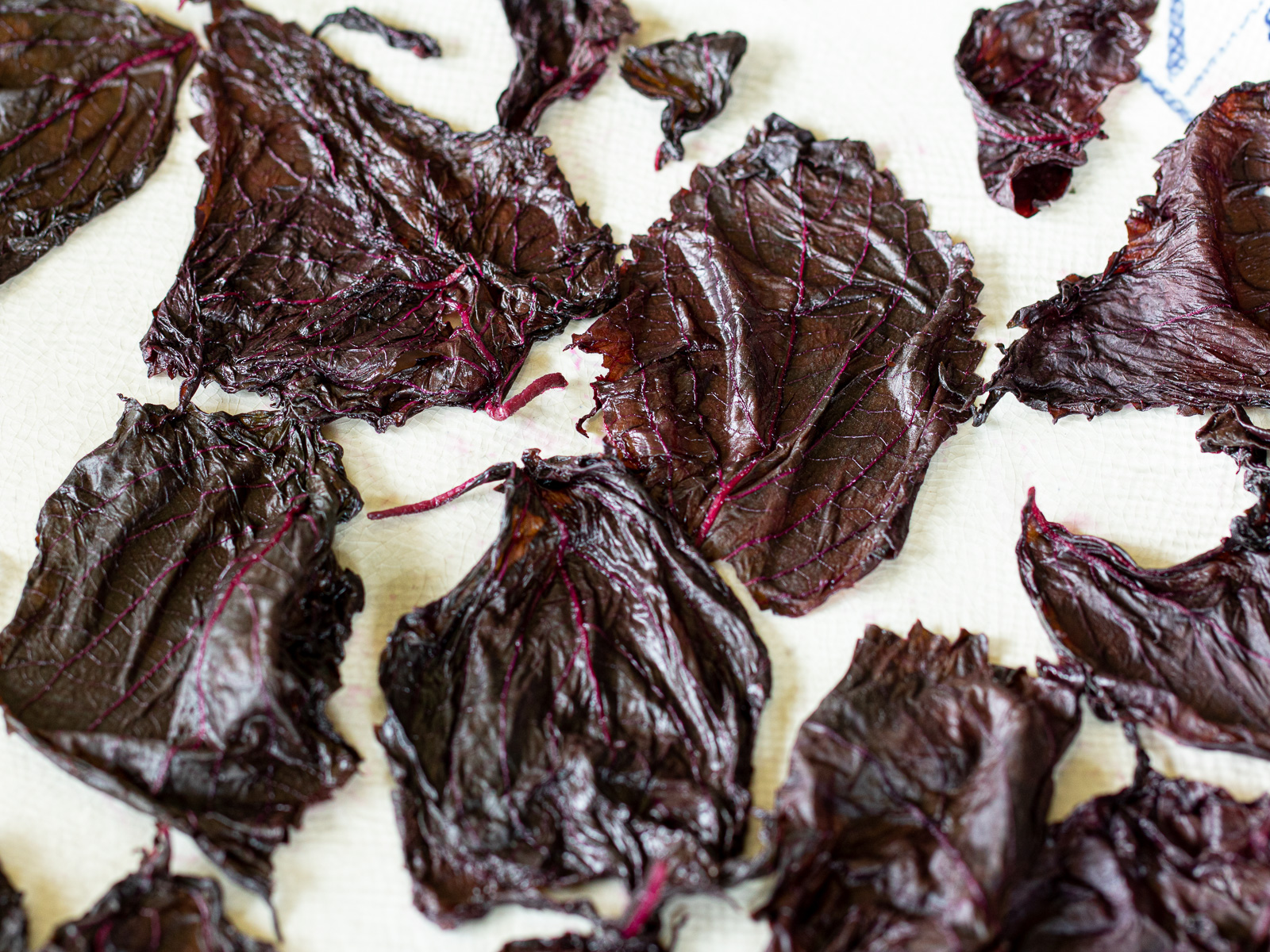
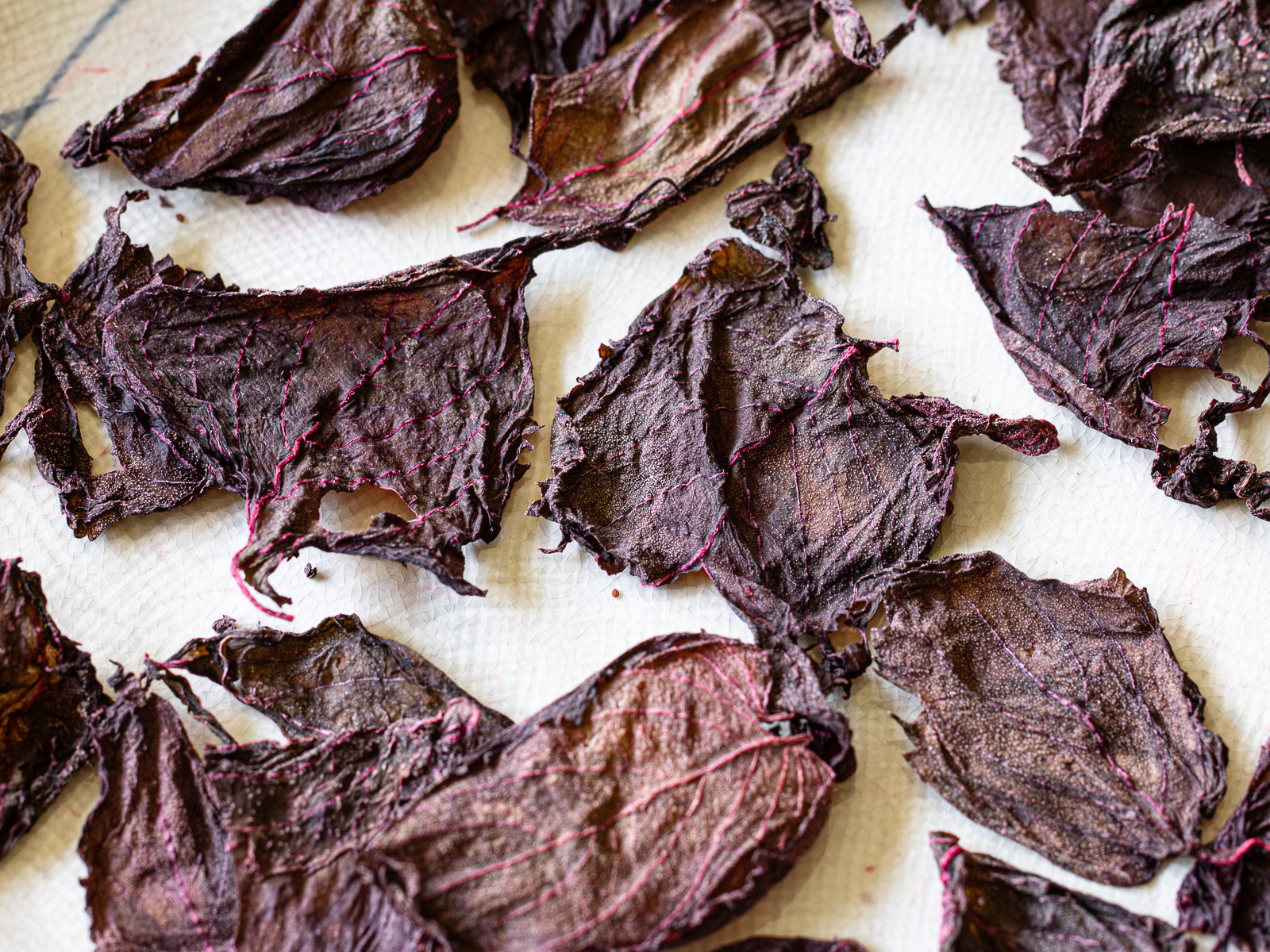
▶ Variation|Using green shiso
The process is the same. Green shiso won’t give the vivid pink of red shiso, but its refreshing aroma is a summer joy of its own. The leaves are softer, with less bitterness, making them surprisingly easy to work with.
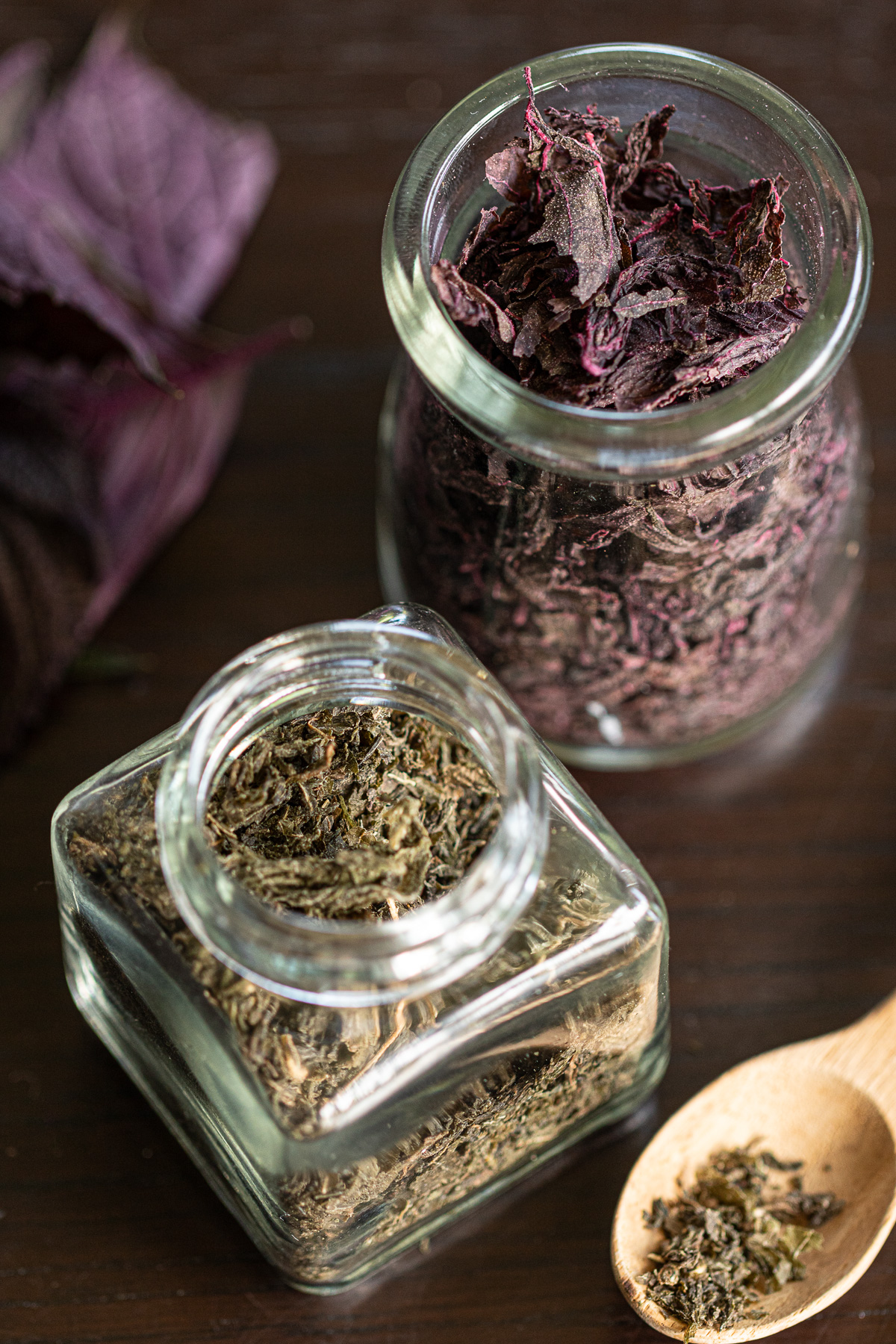
🎨 Summer Recipes to Play with Color
🫙 Bottling Seasonal Memories...
📖 Recipe Card|Printable Recipes
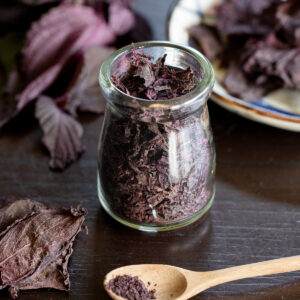
Homemade Red Shiso Furikake (Yukari-Style)
Equipment
- Large mixing bowl – for massaging shiso with salt & wash shiso
- Fine-mesh strainer or colander – to rinse shiso leaves
- Kitchen scale
- Clean kitchen towels – to pat shiso dry
- Plate or tray – for drying shiso
- parchment paper – to prevent sticking while drying
- Airtight jars – for storing finished yukari furikake
- Mortar and pestle or food processor (optional) – to grind dried shiso leaves
Ingredients
- 100 g red shiso leaves (washed and dried)
- 10 g salt (10% of the weight of dried leaves)
- 4 tablespoon ume vinegar (1tbsp for 25 g shiso; adjust proportionally)
Instructions
- Wash Shiso: Submerge the red shiso leaves with stems in a bowl of water. Gently shake the leaves to remove dirt. Drain well.
- Remove Leaves and Dry: Strip the leaves from stems and spread them on a plate or sieve. Dry in a well-ventilated area. Leaves should be slightly soft, not completely crisp.
- Measure Salt: Weigh the dried leaves, then measure 10% of that weight in salt.100 g red shiso leaves
- First Salt Massage: Sprinkle half of the salt over the leaves and mix. Let sit for 30 minutes until the leaves soften.10 g salt
- Massage Thoroughly: Massage the leaves until dark juice appears. Squeeze out excess liquid and discard it.
- Second Salt Massage: Add the remaining salt and massage again until a reddish-purple juice appears. Squeeze and discard excess liquid.
- Add Ume Vinegar: Add ume vinegar (about 1 tablespoon per 25 g of shiso). Gently massage until the leaves turn a vibrant pink.4 tablespoon ume vinegar
- Let Sit: Transfer to a container and let sit overnight to let color set.
- Final Drying: Spread the leaves on a plate or sieve so they do not overlap. Dry completely until crisp. *Sun-drying gives a traditional flavor; shaded drying preserves gentle color and aroma. *If weather is poor, use an oven or toaster at about 80°C for a few minutes, then let residual heat dry them further.
- Store: Transfer dried shiso to a jar, crush lightly with a pestle or chopsticks. Keep sealed at room temperature or refrigerate for longer storage.
Notes
- Can be made with green shiso, though the color is less vivid.
- For stronger flavor, slightly increase salt or adjust after the furikake is ready.
- Best results are with 75–100 g leaves for easy handling and color release.
- If you want it less salty: Gently squeeze out some of the ume vinegar before drying, or use just one tablespoon for a softer taste.
- Sprinkle over steamed rice or rice balls (onigiri)
- Mix into hot rice for simple shiso mixed rice
- Toss with pasta and olive oil for Japanese-style peperoncino
- Combine with cucumber slices for a refreshing salad
- Sprinkle over grated or steamed vegetables like yam or potato
- Add to lightly boiled cabbage or chilled tofu (hiyayakko)
💐 Closing Thoughts
This summer, I played with so many colors.
Soft, chewy banana mochi in a gentle yellow, made from perfectly ripe bananas.
Jelly tinted a delicate pink with common mallow.
And all of this served in a hollowed watermelon bowl with fizzy, refreshing fruit punch.
It became such a vivid summer memory.
As autumn deepens, I wonder—what colors will it bring?
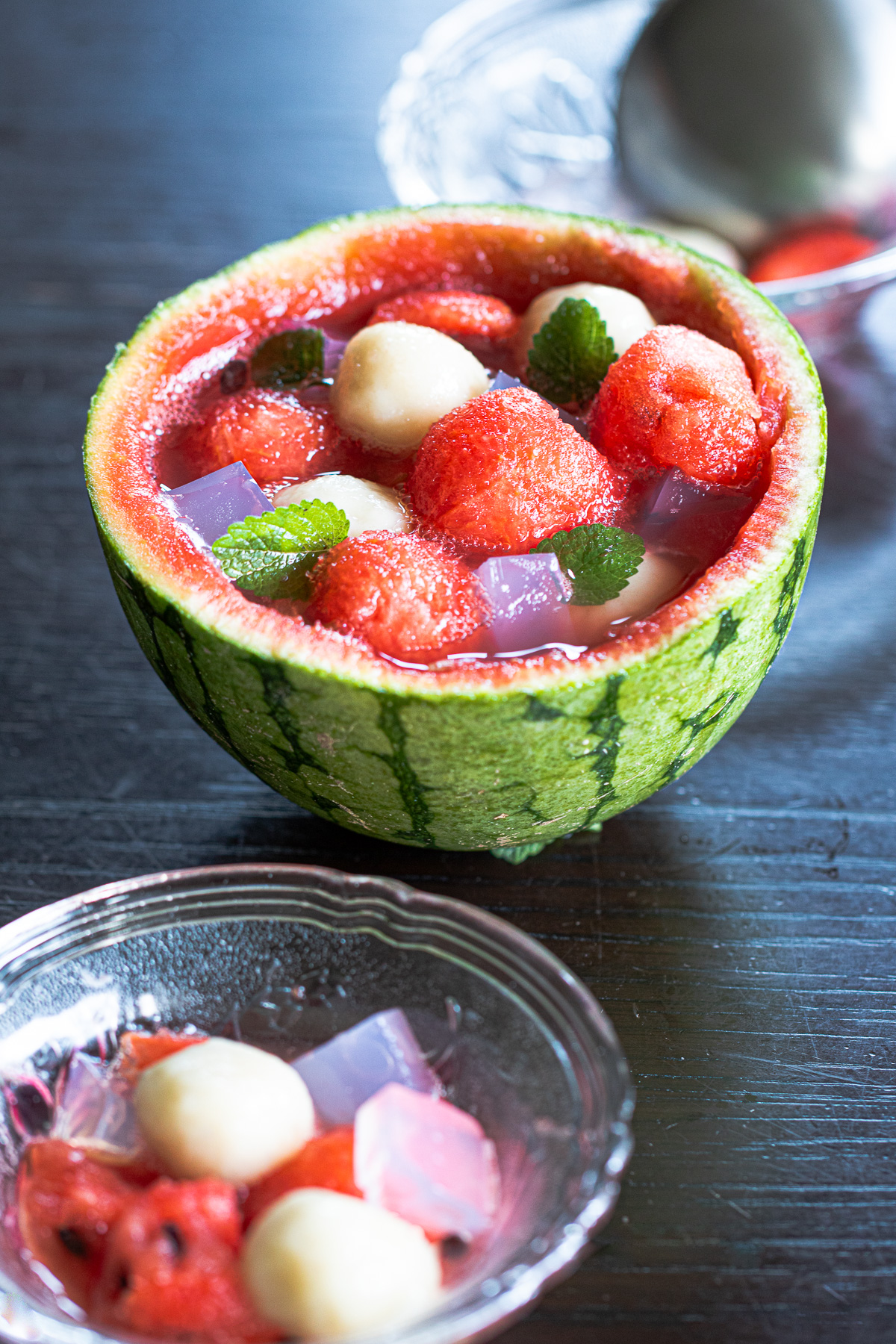


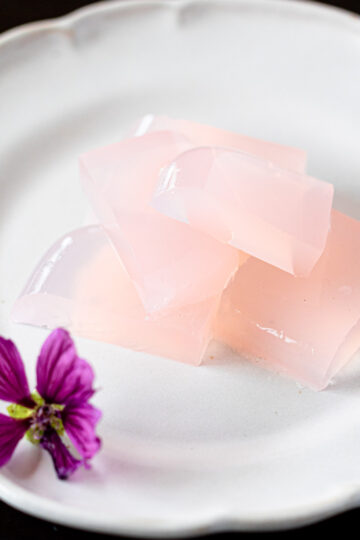
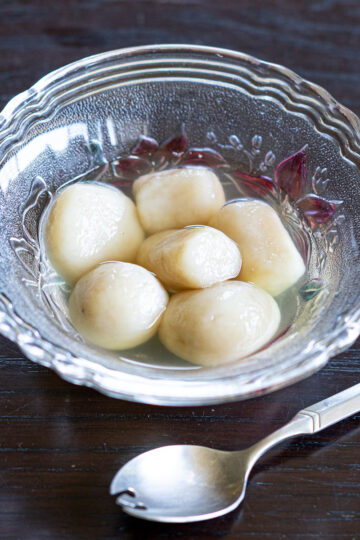
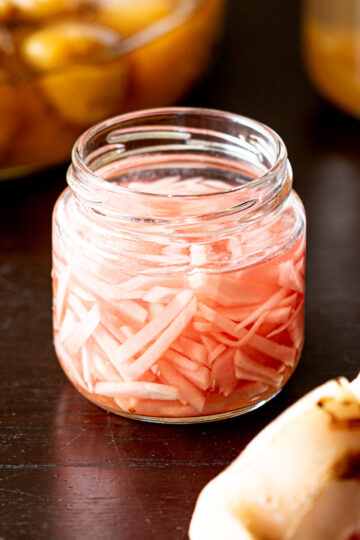
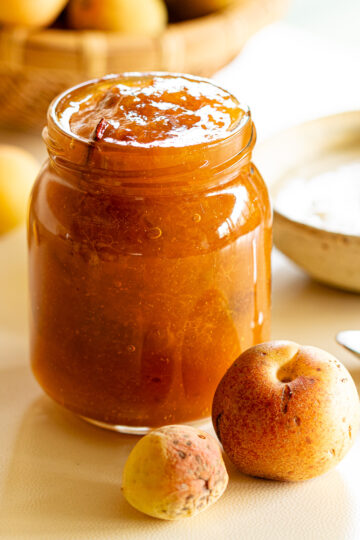
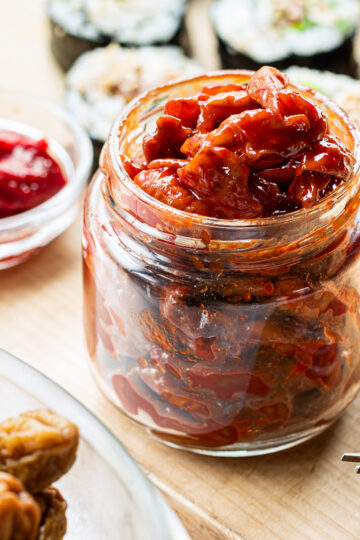
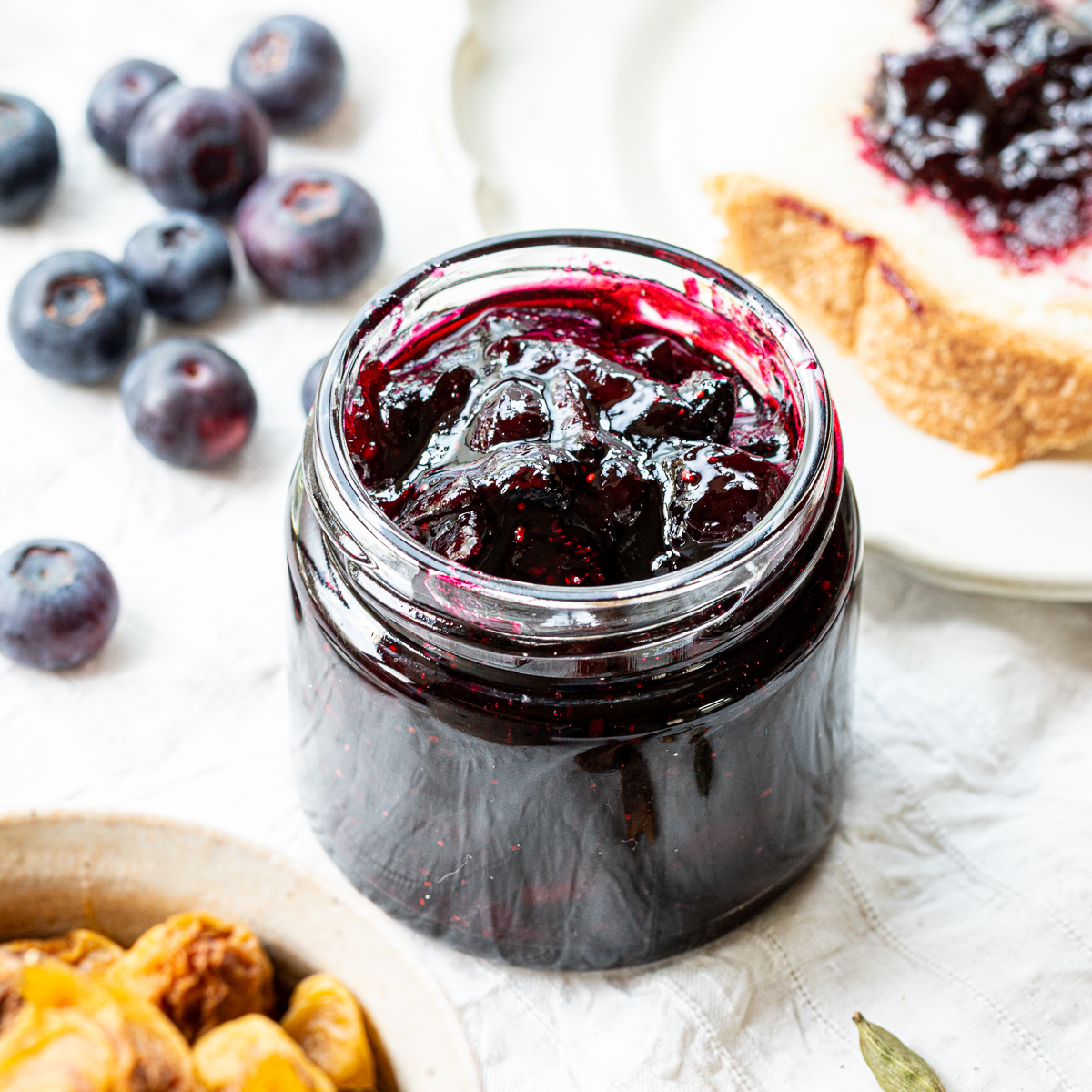
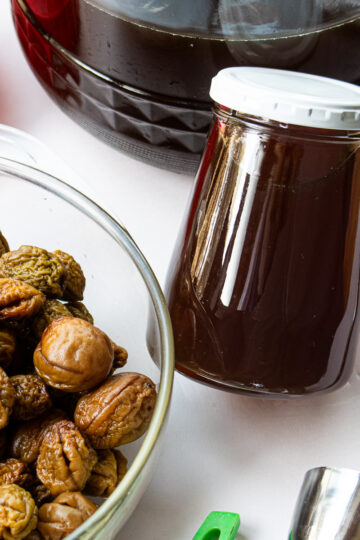

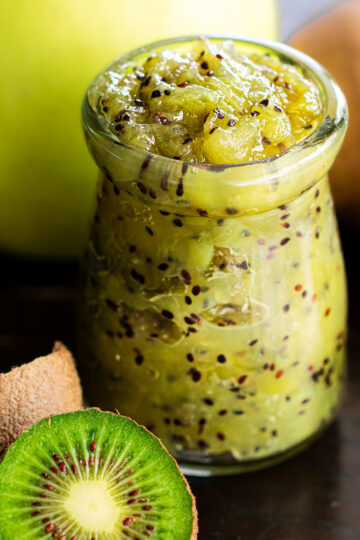
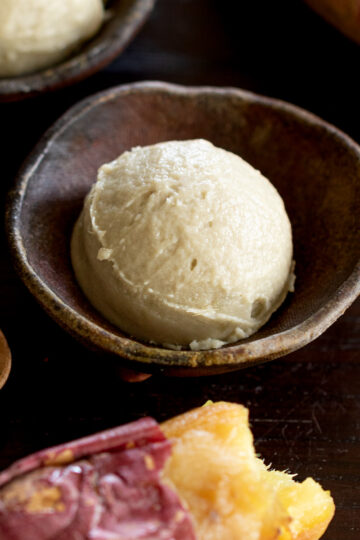
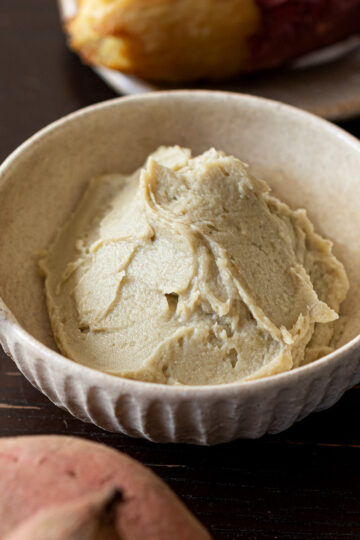

Comments
No Comments